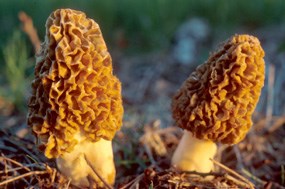
NPS Photo Shenandoah National Park supports over 400 species of fungi. Mushroom development in the park tends to be favored by the moist conditions of Spring and late Fall, but careful observation at any time of year will reveal a wide diversity of fungus on dead wood, leaf litter, and numerous other places within the park. Mushrooms are saprophytic (decomposing) organisms that thrive by breaking down organic matter. Mushrooms and other fungi are critical components of the forest ecosystem because they facilitate the release of nutrients from dead organisms, allowing them to be recycled into new living material. 
NPS Photo Edible mushrooms constitute only a small fraction of the fungus species within the park. Morels (Morchella spp.) are a popular spring edible in Shenandoah. Mushroom hunters look for them when the oak leaves are "the size of a mouse's ear". However, even these relatively easy to identify species need to be carefully differentiated from false morels (Gyromitria spp.) which are harmful if eaten. One of the largest of all fungi, the giant puffball (Calvatia maxima), is also found in the park. This edible fungus can grow up to 50 centimeters (20 inches) in diameter. Related Information McKnight, K.H. and V.B. McKnight. 1987. A Field Guide to Mushrooms of North America. Houghton Mifflin Company, Boston, Massachusetts. Miller, O.K. 1981. Mushrooms of North America. E.P.Dutton, New York, New York. Simpson, R.C. 1992. Macro-fungi checklist: Shenandoah National Park. Unpublished Report. 2 pp. North American Mycological Association Listing of this website does not and is not intended to imply endorsement by the National Park Service of commercial services or products associated with the site. |
Last updated: March 5, 2019
